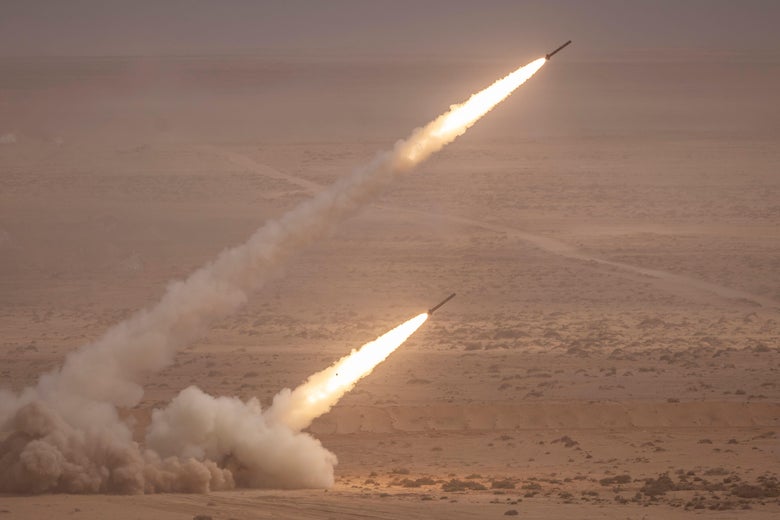FRED KAPLAN

The big news coming out of the war in Ukraine this past month is President Biden’s shipment of a high-tech weapon called HiMARS. It’s been touted as a “very significant factor” on the battlefield, a “game-changer” that has greatly “slowed down the Russian advance.” Is this truth or hype? And what is HiMARS anyway?
On the most basic level, the weapon—first deployed by the U.S. Army in 2005—is what its acronym, fully spelled out, indicates: a High-Mobility Artillery Rocket System. What makes it unlike most artillery rockets—and much more lethal than what the Ukrainian army has had in its arsenal up until now—is that it can fire a wide variety of rockets as far as 50 miles, and, thanks to its GPS guidance system, the rockets can hit their targets with remarkable precision, landing and exploding no more than two to three meters away.
Because of its range and its accuracy, HiMARS has allowed the Ukrainian army to destroy Russian ammunition dumps, command posts, bridges, barracks, and other vital targets well behind Russia’s front lines.
In this sense, HiMARS has leveled the playing field. Until recently, especially in the brutal stand-off in eastern Ukraine, Russian artillery crews could pound Ukrainian positions, while the Ukrainians had nothing with the range to fire back. Now they have something, and the Russians are hurting in ways that they haven’t been hurting before.
Biden, backed by many Western leaders, was initially hesitant to send Ukraine these sorts of weapons because they have the range to strike Russian territory, even from some distance, and therefore might be viewed as provocative. If a U.S.- or NATO-supplied weapon hit Russian territory, Russian President Vladimir Putin might respond by hitting U.S. or NATO targets in Europe—which would escalate the conflict, possibly setting off World War III. However, as Putin kept bombing and shelling Ukrainian civilians well to the west of the battlefield (and after Ukrainian President Volodymyr Zelensky pledged not to hit targets inside Russia), Biden and other Western leaders relaxed their restrictions.
The U.S. has supplied 12 HiMARS, with another four on the way. But Zelensky has said he needs 100—and more ammunition to go with them. He’s unlikely to get that many. For one thing, it takes a few weeks to train Ukrainian soldiers how to use these weapons; even now, the U.S. is sending them faster than the Ukrainians can absorb them. Still, faster delivery could bolster Ukraine’s resistance and even help spark a counteroffensive.
In addition to destroying command posts, bridges, ammo dumps, and other large, fixed targets, HiMARS has also busted up Russian artillery batteries, in some cases a minute after the Russians fired their rockets. U.S.-supplied technology has made this possible: A special radar detects a rocket being fired by a Russian artillery unit, transmits the unit’s latitude and longitude to a data-control network, which directs a particular HiMARS to fire a rocket at precisely that point.
One retired U.S. officer who has been advising the Ukrainians told me, “If Ukraine could do this [rapid counter-firing] more often, Russian [artillery] soldiers would be afraid to go near their guns.” For Ukraine to do this more often, they would need more HiMARS and more rockets for them to fire.
That said, it’s important to note that one new weapon rarely transforms the battlefield irreversibly. Enemies usually counter with a new weapon of their own or with a tactic that adapts to the new situation. The Russians are intensifying their attacks on Ukraine’s heavy artillery pieces—and they have a lot more rockets than Ukraine does. If they had the imagination to do so, the Russians could also disperse their ammunition dumps and place them farther away from the railroad tracks that transport the ammo to the front. (Then again, maybe not: imagination has never been the Russian army’s strong suit.)
There is also the larger geopolitical picture, which is affecting the day-to-day battle more and more directly. Putin has been stepping up his diplomatic game with China, Iran, and Turkey—hoping to turn their converging interests on particular issues into a potent wartime alliance. Xi Jinping has ignored Biden’s pleas to support Ukraine, or at least to stop supporting Russia. After a meeting with Putin just this week, the Ayatollah Khamenei endorsed Russia’s position on the war, supporting the invasion as a necessary preemption to aggression by Ukraine and reportedly sending drones to Russia’s army. Recep Tayyip Erdogan’s interests are mixed—some would drive him to take Ukraine’s side, others might drive him toward Russia’s—but he seems to be drawn to the Moscow-Beijing-Tehran triumvirate, smilingly joining in with the Putin-Khameini powwow despite the backing that Turkey (a member of NATO) has generally given Ukraine.
Putin is doing all he can to bolster this alliance—his trip to Tehran was only the second time he’s been out of the former Soviet Union since the onset of COVID-19—as a way to hold out for another season in his war.* His aim is to keep up the pressure on Ukraine, grab a bit more territory, formally annex a bit more—then hope that in the fall and winter, when the temperatures plummet, Germany and other European countries will succumb to their dependence on Russian oil and gas, take the fix, and drop out of the “sanctions regime” against Russia—and, with it, the unified effort to support Ukraine.
The brutal stalemate on the battlefield is the cover for a desperate race for time. Which will happen first: Ukraine gets the heavy weapons it needs to turn back the Russian army; or the Western alliance frays and falls apart? The U.S. shipment of HiMARS increases the odds for Ukraine, but this race has many laps and hurdles. It’s not nearly finished.
No comments:
Post a Comment